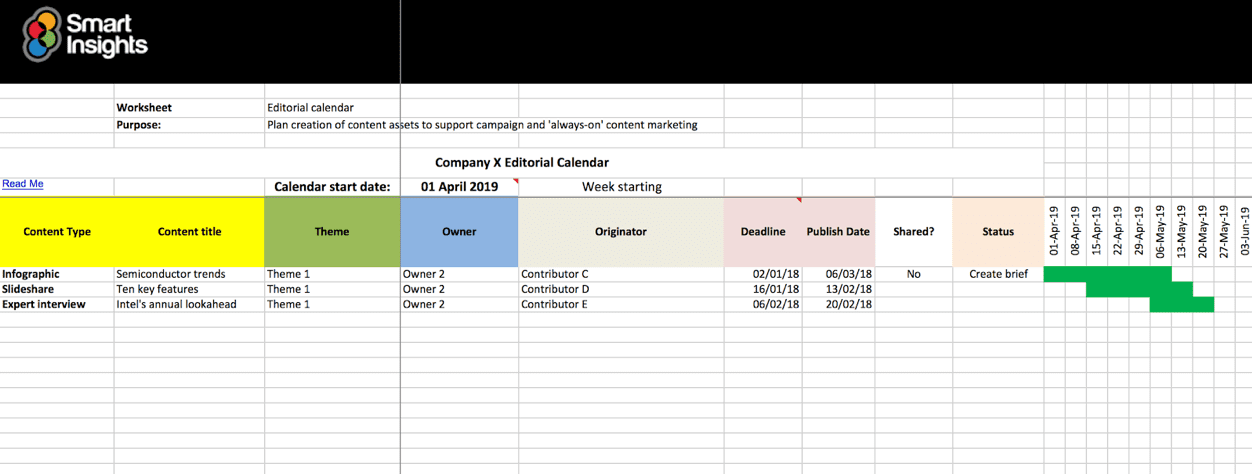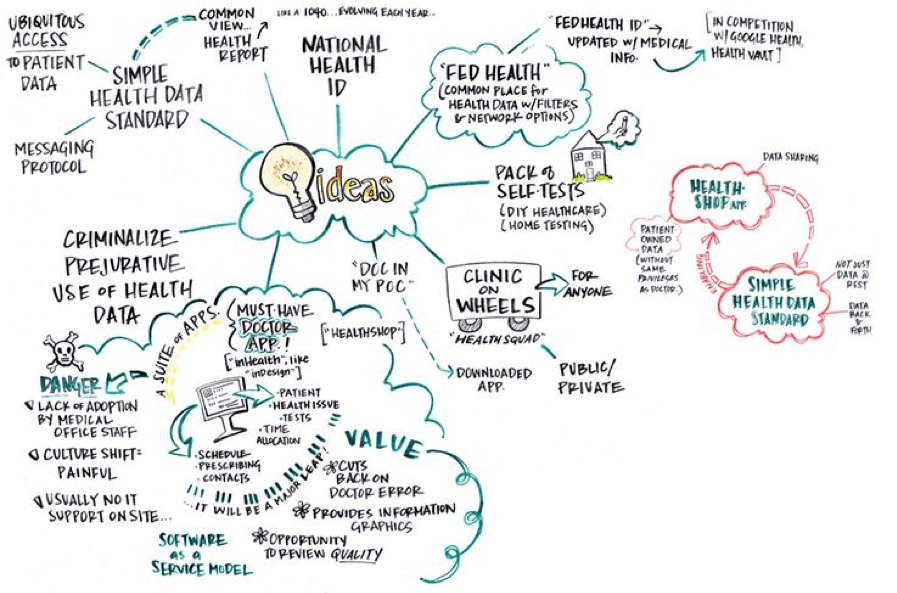Five steps to creating an effective process that generates results
It’s difficult to argue with the benefits that good content marketing can deliver for businesses. We have talked regularly here on Smart Insights about the opportunities provided by great content and how it fuels many inbound marketing techniques, including:
- SEO
- Paid search marketing
- Social media marketing
- Email marketing
- Conversion rate optimization
However, once the overall strategy and approach have been agreed, the next step is execution. Unfortunately, creating and maintaining good quality content is not straightforward. There are often many stakeholders and dependencies across businesses, including marketing, PR, creative and legal/compliance. If you work for an agency you will also need to consider the client’s point of view, too.
Download our Individual Member Resource – Editorial calendar spreadsheet
Use our Excel editorial calendar to effectively plan your campaigns and content schedule for your entire brand.
Access the Editorial calendar spreadsheet
One of the trickiest elements of the content creation process is ideation. Having a high-level view of what content could be produced over the course of the year is all very well, but actually getting down to the detail is much more complicated.
With multiple stakeholders and competing agendas, the editorial meeting is an excellent way of bringing everyone together and working as a team to agree the content you’re going to produce. However, whilst the idea of an editorial meeting is good, putting something into practice that will work requires organization and structure.
What is an editorial meeting?
The editorial meeting is something all publishing companies run on a monthly, weekly and even daily basis. They bring together the key content creator together to discuss and agree on output for current and future editions.
However, whilst the editorial meeting is second nature to publishing companies, it’s still a relatively new concept for many businesses embarking on content marketing for the first time.
The main purpose of an editorial meeting is to:
- Raise the profile of content marketing across the organization.
- Generate content ideas.
- Ensure that the right content is being created, aligned to the overarching strategy and target audience.
- Approve content quickly and efficiently.
- Evaluate content and highlight what is (continue) and isn’t (re-consider/stop) working.
Here are five elements to consider when developing an editorial process:

1. Appoint a leader
An editorial meeting involves coordinating multiple points of view, opinions and agendas. It’s therefore important to have someone in charge who can lead and take ownership of the process.
The leader doesn’t have to be the most senior person involved. However, they do need to have the credibility and desire to bring everyone together and keep the team focused on the business’s key content objectives.
They must also be a passionate advocate for content marketing and be fully invested in the overarching content strategy. The leader will ultimately be the steward of the brand’s content marketing efforts and guide everyone involved in the process.
You may also have an 'executive sponsor', someone in a senior leadership position within the organization who has bought into the content strategy. The executive sponsor will attend meetings every so often and provide guidance and support on behalf of the group.
2. Create a team
The team you put together will shape the theme, topics and type of content you produce. It’s crucial to create a diverse team with a mix of skills and experience. It’s also important to ensure that the team is neither too big nor too small; the former can make the whole process too complex, whilst the latter can result in a narrow view.
Whether you operate client side or agency side, consider bringing in the following disciplines:
- Marketing communications
- Digital
- Brand
- Creative (copy and design)
- PR
- Insights
The mix of data (Insights and Marketing) and creativity (Brand and Creative) will create a team with a balanced perspective and open up new and interesting opportunities.
3. Set an agenda
The agenda you create will set the tone for how editorial meetings will be run on a weekly/monthly basis.
It’s good to have a balance of regular points of order and new features. A suggested agenda may look like the following:
- Strategy review - A review/reminder of the brand’s content strategy and main strategic pillars.
- Insights summary - How last month’s content performed and key highlights and poor performers.
- Upcoming topics and themes - Main areas of focus for the month/quarter ahead, e.g. seasonal events (Christmas, Easter, summer), product launches, PR opportunities etc.
- Content ideation - An opportunity to brainstorm and share ideas based on upcoming topics and themes.
- Distribution - How and where will content be shared? Based on the insight from earlier, is there a need to increase/decrease paid owned/earned media channels?
- Deadlines - Highlight any key deadlines and priority dates.
- Next steps and assignment - Confirm next steps and the responsibilities for each of the main participants.
The editorial meeting should never become too predictable. It’s important to keep it lively and interesting, so introduce new features and ideas. For example, are there any reactive content opportunities, new technology platforms or new attendees to consider?
4. Content ideation
The brainstorming element of the process is very important so it’s worth highlighting this element separately.
To give yourselves the best opportunity to have a productive content ideation section within the meeting, follow these brainstorming top tips:
- Set a clear, common goal.
- Brief participants in advance so they come armed with ideas and information.
- Ensure all ideas are aligned to your common goal and objective (don’t be afraid to call out bad ideas and move on!).
- Create a sense of urgency to generate ideas quickly - you have a finite amount of time.
- Record everything so that ideas can be followed up and fleshed out in more detail.
There are many different tools and techniques to help with generating effective ideas. Test and experiment with a variety of methods and over time you’ll find what works best for you. Some techniques that I have found most effective include:
The 6-5-3 Method
This is a handy technique to encourage the team to think creatively under pressure. It’s based on having six people spend five minutes to come up with three ideas (this can be altered depending on the number of people involved and the time you have).
Once time is up, the ideas are passed onto the next person and the process is repeated again. By the end of the process, you’ll have a range of ideas which can be refined/filtered
Mind mapping
Create a visual map of the main topics and themes. Then start to ideate around each individual topic, generating as many ideas as possible. There may be many primary and sub-ideas but these can be filtered as you go.
The 5 Ws and 1 H
Once you’ve mapped out a series of broad ideas, the 5 Ws and 1 H method can be really helpful to validate and refine into more meaningful topics. This method involves asking a series of questions based on:
-
- Who is the content about/aimed at?
- What is the content about?
- Why does this topic matter (to the target audience)?
- Where will this content be available (online/offline, social, website)?
- When will this content go live?
- How will the target audience be made aware of the content?
5. Plan and execute
The final step in the process is to summarize the discussions and findings from the meeting. At this point in the process, you should have a pretty good idea of what content you have planned for the following month and the roles and responsibilities of everyone involved.
When outlining roles and responsibilities, be clear on timings and scope. This is the best opportunity to align your plan before everyone disperses and goes back to their other day-to-day responsibilities. Follow-up after the meetings with detailed minutes and action points.
If you don’t have the time to build out an action plan within the meeting itself, take everything that’s been recorded and create a plan to distribute along with the meeting minutes. Below is an example of a high- level 'operational' calendar that sets out the broader content assets required.

You will not need to highlight each specific piece of content in detail - that will form part of the editorial calendar. This will be created once everything has been finally signed off and agreed.

Summary
There is no definitive right or wrong way to run an editorial meeting. However, in order to execute a content strategy, businesses need to be organized and align expertise, resources and capabilities.
Businesses embarking on a content marketing approach need to think and act like publishing companies. All publishing companies have a regular cadence of editorial meetings to understand what’s going on and what they will be publishing.
An effective editorial meeting will bring key stakeholders together from a range of different disciplines and ensure that the best content opportunities are surfaced and taken forward. It may seem like a radical step for anyone new to an editorial process, but worth trialling to find what works best for you and your business.











